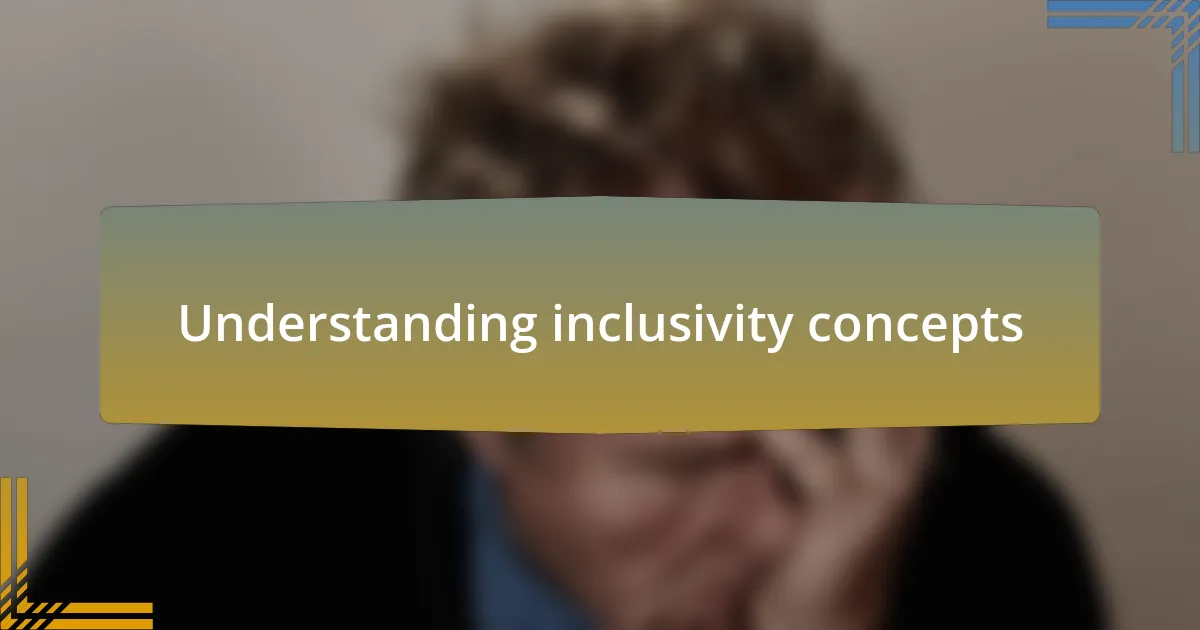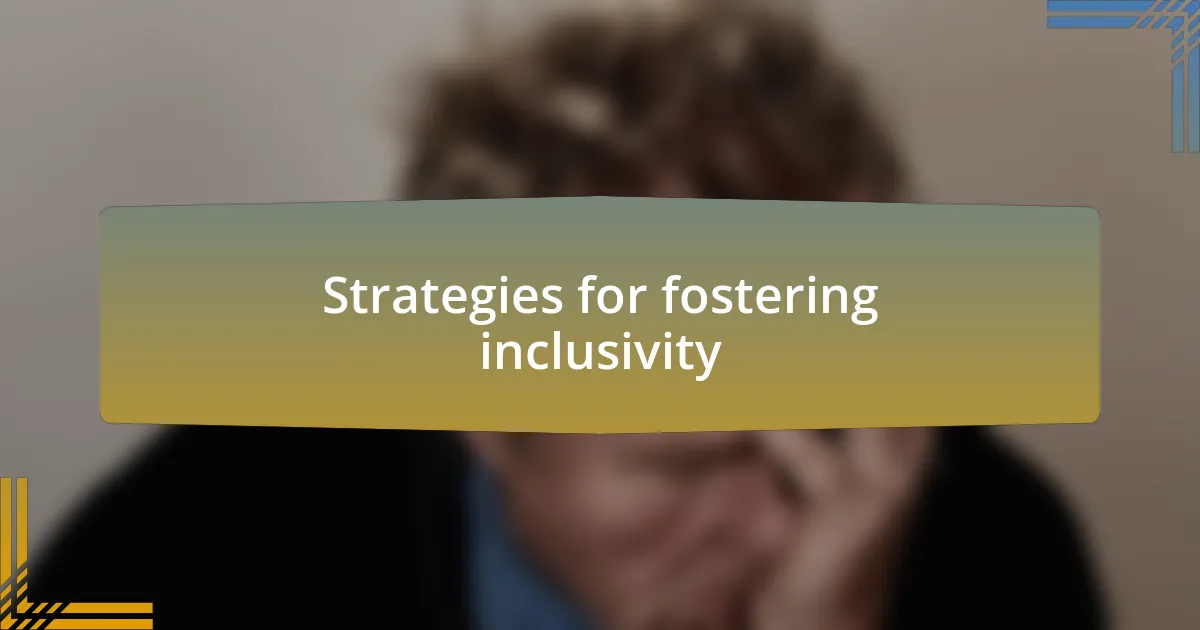Key takeaways:
- Inclusivity goes beyond physical spaces, emphasizing emotional and social dimensions that foster a sense of belonging among individuals from diverse backgrounds.
- Creating inclusive environments involves prioritizing accessibility, offering varied social activities, and cultivating a culture of respect and understanding among residents and staff.
- Involving residents in decision-making and gathering their feedback is crucial for fostering a sense of community and belonging.
- Overcoming challenges in implementing inclusivity requires addressing staff resistance, demonstrating the benefits of technology, and utilizing personal narratives to advocate for necessary changes.

Understanding inclusivity concepts
Inclusivity is more than just a buzzword; it’s about creating an environment where everyone feels valued and respected. I remember visiting a retirement community where the diverse backgrounds of residents shone brightly in shared activities; it struck me how much richer life can be when everyone is included. Can you imagine how deeply a sense of belonging can impact one’s happiness?
When we talk about inclusivity, we often think about physical space, but it also encompasses emotional and social aspects. I’m often reminded of a close friend who felt isolated in her previous home because the social events didn’t appeal to her interests. This experience highlights the importance of embracing varied activities that cater to different preferences and backgrounds, fostering a true sense of community.
Understanding inclusivity means recognizing that everyone brings unique experiences to the table. I once had a conversation with a resident who shared her journey as an artist; her talent not only enriched her life but also inspired others. Isn’t it fascinating how one person’s story can motivate and connect individuals from different walks of life? This is the essence of inclusivity—encouraging dialogue and interactions that celebrate our differences.

Key features of inclusive environments
Creating inclusive environments involves prioritizing accessibility to ensure that everyone, regardless of physical ability, can comfortably navigate the space. I recall touring a luxury retirement home that incorporated ramps, wide doorways, and thoughtfully designed layouts. This attention to physical features not only made movement easier but also demonstrated respect for everyone’s right to enjoy communal areas, don’t you think?
Equally important is the emphasis on creating varied social spaces that cater to different interests and needs. I once attended a book club where the selections weren’t solely popular bestsellers; the organizer made a point to include works by authors from diverse backgrounds. This approach sparked richer discussions, allowing residents to share perspectives shaped by their unique life experiences. Can you feel the difference when conversations flow freely and everyone has something to contribute?
Lastly, fostering a culture of respect and understanding among residents and staff is essential for inclusivity. I remember volunteering at an event where staff actively encouraged residents to share their life stories with one another. The warmth in the room was palpable; it was heartening to witness connections being formed through empathy. Isn’t it powerful to think about how these authentic interactions create a more vibrant and cohesive community?

Strategies for fostering inclusivity
To foster inclusivity, one effective strategy is incorporating feedback from residents about their needs and preferences. I remember a particular meeting where residents were invited to voice their thoughts on activities. The enthusiasm in the room was contagious, and it became clear how deeply people wanted to feel valued. Wouldn’t it be invigorating to see their insights directly shape community offerings?
Another powerful approach is training staff on cultural competence and sensitivity. I once participated in a workshop focused on understanding the diverse backgrounds of residents. This experience opened my eyes to the nuances of communication and the importance of respectful engagement. Can you imagine the difference it makes when staff can truly connect with residents from all walks of life?
Additionally, hosting community events that celebrate diversity can greatly enhance inclusivity. I recall a potluck where each resident brought a dish from their cultural heritage. The joy in sharing stories behind each meal was palpable, creating bonds that transcended barriers. Isn’t it amazing how something as simple as food can bring people together and make everyone feel at home?

Personal experiences in inclusive design
Inclusive design in a retirement community can transform not only the physical environment but also the emotional landscape. I vividly remember redesigning a communal space based on feedback from residents. One resident, who used a wheelchair, suggested widening doorways for easier access. The moment we made that change, the relief and appreciation on their face were unmistakable. It ignited my passion for advocating for such thoughtful adjustments.
During a recent project, I witnessed firsthand the importance of creating sensory-friendly spaces. We set up quiet zones with soft lighting and calming colors for residents who felt overwhelmed by noise. One afternoon, a resident approached me with teary eyes, expressing how these changes allowed her to feel safe and at peace. It reminded me that even small adjustments could have profound impacts on quality of life.
I also learned that involving residents in the decision-making process fosters a deeper sense of belonging. I held informal brainstorming sessions with various groups, encouraging everyone to share their ideas. One resident, an artist, suggested incorporating art that reflects the community’s diversity. The collaborative spirit that emerged not only enriched our environment but also reinforced the idea that everyone has valuable contributions. How powerful it is when people feel their voices matter!

Overcoming challenges in implementation
Implementing inclusivity in a luxury retirement home often involves navigating various challenges, but I’ve found that addressing these obstacles head-on is critical. For instance, during a project aimed at enhancing social engagement, I noticed resistance from some staff members who were set in their routines. By organizing workshops that enlightened them about the benefits of inclusivity—not just for residents but for the overall community—we slowly began to shift perceptions and improve participation.
Another challenge arose when introducing technology to enhance accessibility. Initially, some residents were hesitant, fearing the gadgets would complicate their lives. I recall a meeting where we demonstrated how simple voice-activated devices could empower them to control their environment. Watching their faces light up as they realized technology could bring independence was a turning point for many.
Finally, funding often presents a barrier to implementing these inclusive measures. I remember pitching a proposal for sensory spaces in common areas at a budget meeting, feeling the weight of skepticism in the room. But sharing stories from residents who found solace in similar environments made a difference. It’s moments like these that show how personal narratives can effectively advocate for necessary changes, turning challenges into opportunities for growth.